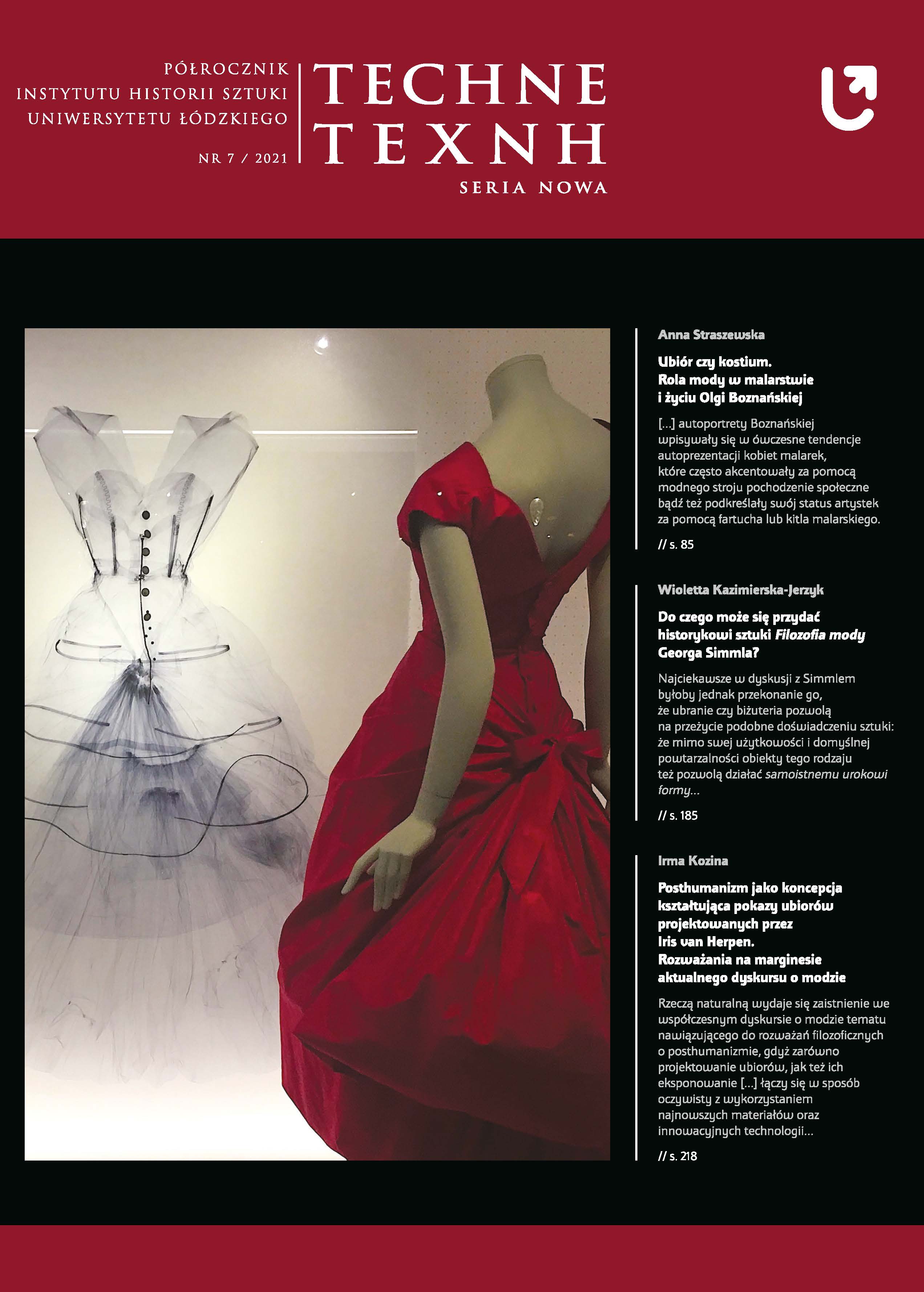Posthumanizm jako koncepcja kształtująca pokazy ubiorów projektowanych przez Iris van Herpen? Rozważania na marginesie aktualnego dyskursu o modzie
DOI:
https://doi.org/10.18778/2084-851X.11.11Słowa kluczowe:
Iris Van Herpen, posthumanism in fashion, Gucci, Alesssandro Michelle, posthumanismAbstrakt
Fascynacja nowymi materiałami i innowacyjną technologią zapewniła holenderskiej projektantce mody Iris van Herpen jedną z czołowych pozycji pośród twórców łączonych w dyskursie teoretycznym z tendencją określaną mianem posthumanizmu. Analiza narracji obecnych w rozważaniach współczesnych krytyków modowych prowadzi do wniosku, że posthumanizm nie jest zazwyczaj definiowany jednoznacznie. Jedni postrzegają go jako idealizowaną wizję przyszłości wolnej od binarnego klasyfikowania rzeczywistości za pomocą dychotomicznych par: dobro – zło, przyroda – cywilizacja itp., inni natomiast kojarzą ten nurt z utratą tożsamości wypracowanej przez biologiczny gatunek homo sapiens i widzą w nim nawet dystopijny kres ludzkości. W artykule podjęto próbę przedstawienia związku koncepcji posthumanizmu z twórczością projektową Iris van Herpen, odnosząc się zwłaszcza do kolekcji przygotowanych przez nią we współpracy z Neri Oxman i Philipem Beesleyem. Przeprowadzono też porównanie wątków posthumanistycznych wykorzystywanych przez van Herpen z analogiczną koncepcją obecną w pokazie cyborgicznym przygotowanym w 2018 roku przez dyrektora artystycznego domu mody Gucci Alessandra Michelego.
Bibliografia
BEESLEY 2010 – Philip Beesley, Afterword: Immanence and Empathy, [in:] Hylozoic Ground: Liminal Responsive Architecture, ed. Pernilla Ohrstedt, Hailey Isaacs, Toronto 2010, s. 174–177.
Google Scholar
BRAIDOTTI 2014 – Rosi Braidotti, Po człowieku, tłum. Joanna Bednarek, Agnieszka Kowalczyk, Warszawa 2014.
Google Scholar
BRAIDOTTI/HLAVAJOVA 2018 – Rosi Braidotti, Maria Hlavajova, The Posthuman Glossary, London 2018.
Google Scholar
GAJEWSKA 2013 – Grażyna Gajewska, Światopoglądowa i stylistyczna katachreza Michela Foucaulta i Donny Haraway, „Studia Europaea Gnesnensia”, nr 8 (2013), s. 159–177.
Google Scholar
GAJEWSKA 2020 – Grażyna Gajewska, Myśleć fantastyką. Przez science fiction do posthumanizmu, „Images”, vol. XXVIII (2020), nr 37, s. 5–19.
Google Scholar
DOI: https://doi.org/10.14746/i.2020.37.01
GUNIA 2015 – Artur Gunia, Dlaczego stajemy się cyborgami – problem adaptacyjności umysłu i ciała do wytworów technologii, [w:] Umysł i poznanie, red. Milena Jakubiak, Marta Kaszubowska, Szczecin 2015, s. 101–111.
Google Scholar
HARAWAY 2003 – Donna Haraway, Manifest cyborgów: nauka, technologia i feminizm socjalny lat osiemdziesiątych, „Przegląd Filozoficzno-Literacki”, nr 1(3) (2003), s. 49–87, pierwodruk w języku angielskim ukazał się w 1985 r.
Google Scholar
KOZINA 2017 – Irma Kozina, Historia mody. Od krynoliny do mini, Warszawa 2017.
Google Scholar
KURZWEIL 2018 – Ray Kurzweil, Jak stworzyć umysł: sekrety ludzkich myśli ujawnione, Białystok 2018.
Google Scholar
PEPPERELLA 2010 – Robert Pepperella, Posthumanism and the Challenge of New Ideas, [in:] Kinetic Architectures & Geotextile Installations, ed. Philip Beesley, Toronto 2010, s. 35–40.
Google Scholar
SZYMAŃSKI 2019 – Kamil Szymański, Osobliwość Raymonda Kurzweila jako wizja dziejów, „Hybris”, nr 46 (2019), s. 51–68.
Google Scholar
BORELLI-PERSON 2017 – Laird Borrelli-Persson, Iris van Herpen. Spring 2011 Ready-to-Wear, Vogue Runway, https://www.vogue.com/fashion-shows/spring-2011-ready-to-wear/iris-van-herpen [dostęp 25.11.2021].
Google Scholar
BRAIDOTTI 2019 – Rosi Braidotti, Posthuman Knowledge, YouTube, https://www.youtube.com/watch?v=0CewnVzOg5w [dostęp 25.11.2021].
Google Scholar
BROWN 2020 – Annie Brown, Timely enchantress: The high tech couture of Iris van Herpen, „Financial Review”, https://www.afr.com/life-and-luxury/fashion-and-style/timely-enchantress-the-high-tech-couture-of-iris-van-herpen-20200714-p55bt1 [dostęp 25.11.2021].
Google Scholar
CHALCRAFT 2013 – Emilie Chalcraft, Voltage by Iris van Herpen with Neri Oxman and Julia Koerner, Dezeen, 22 stycznia 2013, https://www.dezeen.com/2013/01/22/voltage-3d-printed-clothes-by-iris-van-herpen-with-neri-oxman-and-julia-koerne/ [dostęp 25.11.2021].
Google Scholar
ETHERINGTON 2010 – Rose Etherington, Hylozoic Ground by Philip Beesley, Dezeen 27 sierpnia 2010, https://www.dezeen.com/2010/08/27/hylozoic-ground-by-philip-beesley/ [dostęp 18.12.2021].
Google Scholar
FALCON-LANG 2011 – Howard Falcon-Lang, Anthropocene: Have humans created a new geological age?, BBC News: Science, https://www.bbc.com/news/science-environment-13335683 [dostęp 25.11.2021].
Google Scholar
HERPEN 2012 – Iris van Herpen, Hybrid Holism. https://www.irisvanherpen.com/collections/hybrid-holism [dostęp 18.12.2021].
Google Scholar
HERPEN/BEESLEY 2016 – Iris van Herpen and Philip Beesley in dialogue at ACADIA 2016, http://acadia.org/news/GV9EVC [dostęp 18.12.2021].
Google Scholar
HYLAND 2016 – Véronique Hyland, The Designer Who Mixes Cutting-Edge Technology with Couture Tradition, The Cut, 1 maja 2016, https://www.thecut.com/2016/04/designer-who-mixes-technology-with-couture.html [dostęp 25.11.2021].
Google Scholar
KOWALCZYK 2018 – Gabriel Kowalczyk, Człowiek zwany rozumnym, Filmweb, -https://www.filmweb.pl/reviews/recenzja-filmu-Antropocen%3A+Epoka+cz%C5%82owieka-22557 [dostęp 25.11.2021].
Google Scholar
KRAKOWIAK 2009 – Ludwik Krakowiak, Nanotechnologia zapewni nam nieśmiertelność?, PCWorld, 1 października 2009, https://www.pcworld.pl/news/Nanotechnologia-zapewni-nam-niesmiertelnosc,350704.html [dostęp 25.11.2021].
Google Scholar
MARKIEWICZ 2015 – Miłosz Markiewicz, We are in this together (Rosi Braidotti: „Po człowieku”), „ArtPapier”, nr 4 (268) (2015), http://artpapier.com/index.php?page=artykul&wydanie=218&artykul=4800 [dostęp 25.11.2021].
Google Scholar
MICHELE 2020 – Gucci’s Creative Director Alessandro Michele Shares His Personal Diary. “Da Man Magazine” 28 maja 2020, https://daman.co.id/guccis-creative-director-alessandro-michele-shares-his-personal-diary/ [dostęp 18.12.2021].
Google Scholar
Milionerka 2020 – Milionerka: ile zarabia Lil Miquela, słynna wirtualna modelka?, „Sukces. Rzeczpospolita”, https://sukces.rp.pl/styl/art17716031-milionerka-ile-zarabia-lil-miquela-slynna-wirtualna-modelka [dostęp 25.11.2021].
Google Scholar
MOROZ 2014 – Sara Moroz, Q&A: Iris van Herpen on Couture, Her Shrink-Wrapped Models, & More, The Cut, 11 kwietnia 2014, https://www.thecut.com/2014/03/iris-van-herpen-on-shrink-wrapped-models-more.html [dostęp 25.11.2021].
Google Scholar
PERKINS 2019 – Sarah Perkins, The Cyborg Aesthetics of Dress: Examining Reactions to the Corporeal Evolution of the Cyborg from 1960 to 2018, The Tortoiseshell, https://tortoise.princeton.edu/2019/05/09/the-cyborg-aesthetic-of-dress-examining-reactions-to-the-corporeal-evolution-of-the-cyborg-from-1960-to-2018/ [dostęp 25.11.2021].
Google Scholar
PETRARCA 2018 – Emilia Petrarca, Meet Gucci’s Post-Human, Post-Identity, Woke Cyborg, The Cut, https://www.thecut.com/2018/02/gucci-fall-2018-runway-recap.html [dostęp 25.11.2021].
Google Scholar
SCHLITT 2018 – Alexis Schlitt, Iris van Herpen, Crystallization Water Dress, Prezi, https://prezi.com/p/gnmtm8dhzbjq/iris-van-herpen-crystallisation-water-dress/ [dostęp 25.11.2021].
Google Scholar
SHRESTY 2021 – Sharanya Shresty, Anthozoa by Neri Oxman: Printed Dress, Rethinking The Future, https://www.re-thinkingthefuture.com/case-studies/a4850-anthozoa-by-neri-oxman-3d-printed-dress/ [dostęp 25.11.2021].
Google Scholar
SMELIK 2020 – Anneke Smelik, Fractal Folds: The Posthuman Fashion of Iris van Herpen, „Fashion Theory. The Journal of Dress, Body & Culture”, December 2020, https://www.tandfonline.com/doi/full/10.1080/1362704X.2020.1850035 [dostęp 25.11.2021].
Google Scholar
DOI: https://doi.org/10.1080/1362704X.2020.1850035
Pobrania
Opublikowane
Jak cytować
Numer
Dział
Licencja

Utwór dostępny jest na licencji Creative Commons Uznanie autorstwa – Użycie niekomercyjne – Bez utworów zależnych 4.0 Międzynarodowe.








